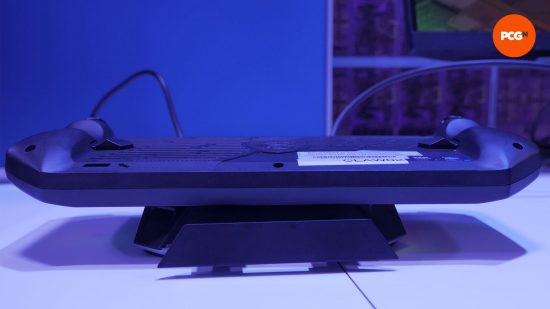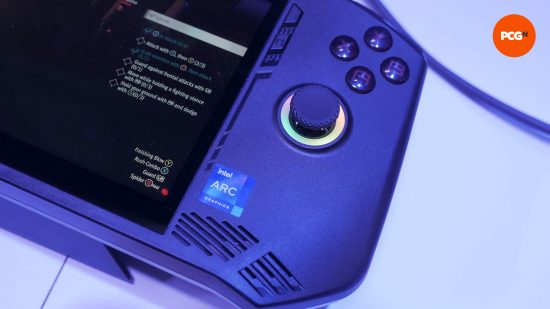MSI and Intel shocked many of the PC gaming world a few days in the past by asserting a brand-new gaming handheld powered not by an AMD APU however by considered one of Intel’s one new Core Extremely chips. The MSI Claw was introduced at CES 2024, the place I acquired hands-on with the brand new system to see the way it shapes up in opposition to the competitors.
The Claw shall be taking up the likes of the Steam Deck, Asus ROG Ally, and Lenovo Legion Go for the title of greatest gaming handheld, in what’s proving to be a quickly extra aggressive market. Priced at $699.99, it’s barely cheaper than the Ally and Legion Go however pricier than the Steam Deck.
MSI Claw specs
| MSI Claw | Asus ROG Ally | Steam Deck OLED | |
| Dimensions | 294 x 117 x 21.2 mm | 280 x 111 x 32mm | 298 mm × 117 mm × 49 mm |
| Weight | 675g | 608g | 640g |
| Processor | Intel Core Extremely 155H | AMD Z1 Excessive | Customized AMD APU |
| Cores | 6P+8E+2LP-E | 8 | 4 |
| GPU cores | 8 Xe cores | 12CU | 8CU |
| TDP vary | 15-45W | 10-30W | 5-15W |
| Value | $699 | $799 | $549 |
MSI Claw design
The MSI Claw sits firmly within the “Steam Deck rival” camp with regards to gaming handhelds, with it being very related in form and measurement to that system. That’s versus it providing one thing a bit completely different like with the Lenovo Legion Go, with its chunkier measurement and detachable controllers.
Related although it’s, the Claw has some delicate variations between it and its most important rivals. For a begin, by way of uncooked dimensions, the Claw is true in between the Ally and Steam Deck for total measurement, being a number of millimeters narrower than the Steam Deck and thinner than each the Ally and Steam Deck – though this determine appears to refer to only the center thickness of the system, not together with the aspect grips, which is a bit deceptive. It’s a contact heavier than it’s most important opponents, although, coming in at 675g in comparison with 640g for the Deck and a mere 608g for the Ally.

In apply, most of those measurements make little distinction. As an alternative, its in subtler ways in which the gadgets really feel completely different. For example, the Claw has aspect grips which might be a bit of fuller than the ROG Ally however not as deep because the Steam Deck. As such, it sits a bit of extra comfortably within the hand than the Ally however not as comfortably because the Steam Deck. The compromise being that the thicker the grips, the chunkier the system total.

Another design subtleties embrace the ABXY buttons having RGB backlighting, which is kind of properly built-in. In any other case, although, there’s little right here that actually units the Claw aside from the Deck or Ally, although the rear buttons I did discover simpler to activate than these of the Ally.

By way of precise styling, I believe the Claw might be the least attraction of the above three gadgets. The Ally has the smooth white look all sewn up whereas there’s a utilitarian high quality to the all-black Deck. The Claw, although, is only a bit extra daring with its RGB and has a number of particulars on the plastic casing that aren’t fairly so clear.
MSI Claw options
Simply because the outer design of the Claw is similar to the Deck and Ally, so are its core options, with it that includes a seemingly similar 7-inch 1080 LCD display to the Ally and really related button format. The display seems very good in particular person and whereas the Steam Deck OLED’s show does outdo each for distinction and – oddly sufficient for an OLED panel – moments of occasional brightness, the Claw’s display remains to be very good certainly.

Furthermore, I’ve all the time been one of many naysayers with regards to the Steam Deck’s display decision and it’s whole give attention to being a gaming handheld. I’ve all the time preferred the upper display decision and flexibility of the varied Home windows gaming handhelds and that’s true right here too – when you’re doing something apart from gaming, the Claw will beat out the Deck on the very least.

Up on the highest fringe of the Claw, alongside the headphone jack, quantity buttons, and microSD slot it a USB-C port that may additionally do Thunderbolt, permitting for simple connection to Thunderbolt hub gadgets for passing audio, video, and different knowledge backwards and forwards. In apply, this implies you’ll be able to simply do issues like hook up a monitor, keyboard, and mouse by way of a single port to sport on a bigger display. Not a revelation nevertheless it actually labored nicely within the demo MSI had setup.
MSI Claw gaming efficiency
One of many key claims by MSI and Intel in regards to the Claw is that it may possibly supply even higher efficiency than current AMD-powered gaming handhelds, thanks partly to having a a lot greater maximu TDP of 45W, in comparison with 30W for the Ally and simply 15W for the Stead Deck OLED.

We don’t but have numbers to again this up however actually the system felt prefer it was enjoying the video games it was working fairly easily and offered a completely satisfying gaming expertise. In the meantime, testing by another sources evaluating the Claw in 30W mode and the Ally in 25W mode present they’ve very related efficiency at 720p, averaging 50fps for the Claw and 49fps for the Ally. Primarily based on these figures, the next 45W looks like it could be capable of unlock fairly a bit of additional efficiency.
On the different finish of the dimensions, a 15W minimal TDP for the Claw appears extremely power-hungry, notably in comparison with the Steam Deck, suggesting battery life in less-demanding video games could possibly be worse than these gadgets.
MSI Claw battery life
As simply talked about, the Claw has a a lot greater minimal TDP than its opponents, which might recommend a decrease battery life. Nevertheless, MSI is bolding claiming that the Claw can have as a lot as 50% greater battery life than the Ally.

What’s attention-grabbing about that is that whereas the Claw does even have a a lot greater capability battery – 54Wh in comparison with 40Wh – it’s nonetheless no the place close to 50% bigger, so clearly there’s both some quantity fudging happening with evaluating completely different TDPs or the Claw’s Intel processor does have some secret power-sipping sauce. Regardless of the case, we’ll must correctly check the system to really discover out.
MSI Claw preliminary ideas
The MSI Claw seems each bit prefer it could possibly be a significant rival to the AMD-powered gaming handhelds of the world. The core appear and feel of the system is spot on, preliminary efficiency appears good, and there are some daring claims being made about wider efficiency and battery life.
The MSI Claw price can also be aggressive, undercutting its most direct rivals by $100. If its efficiency actually is nearly as good as MSI and Intel declare, that’ll make for a really compelling mixture.
For extra of our ideas on the most recent cellular gaming gadgets, try our best gaming handheld information.





Comments are closed.